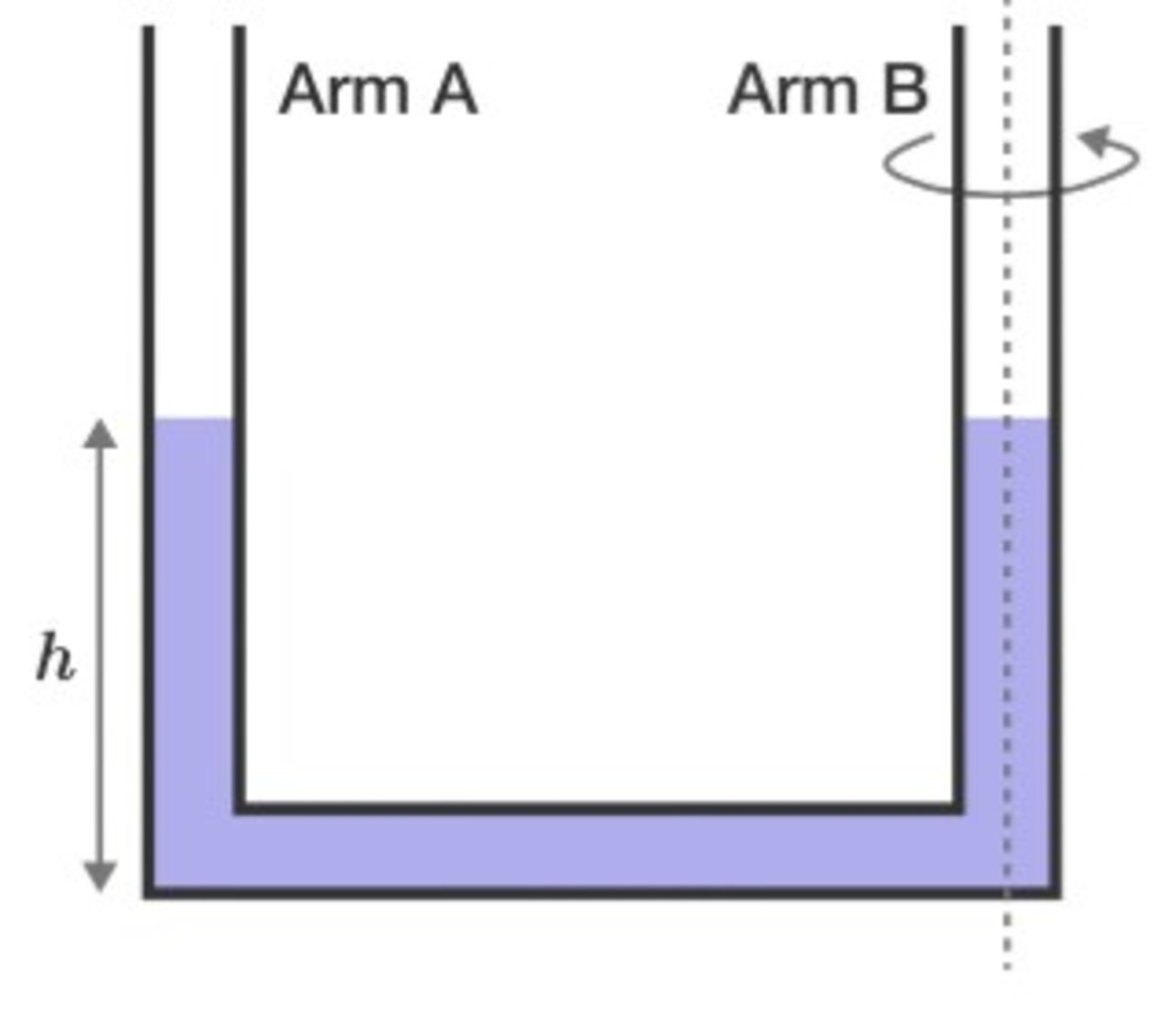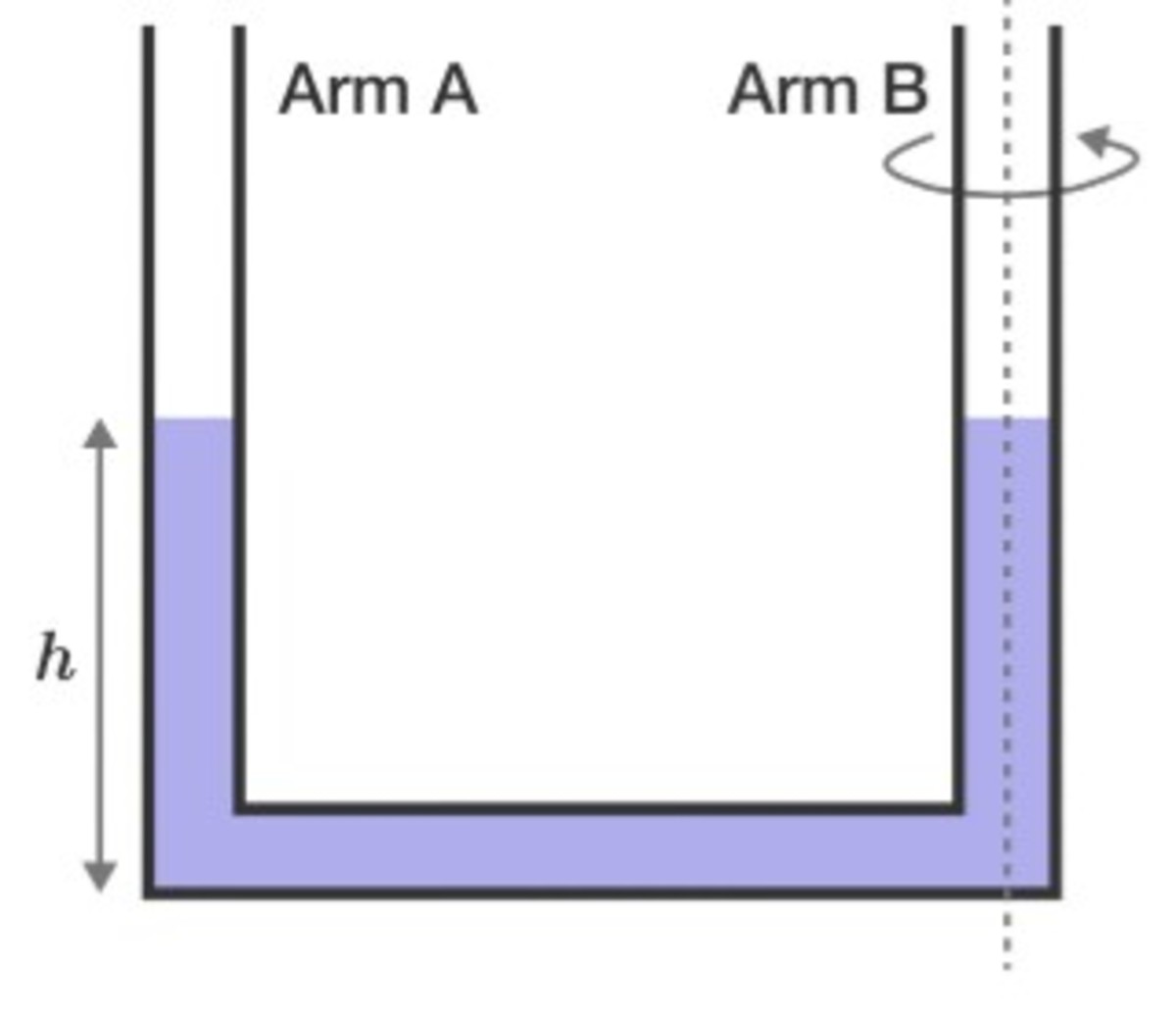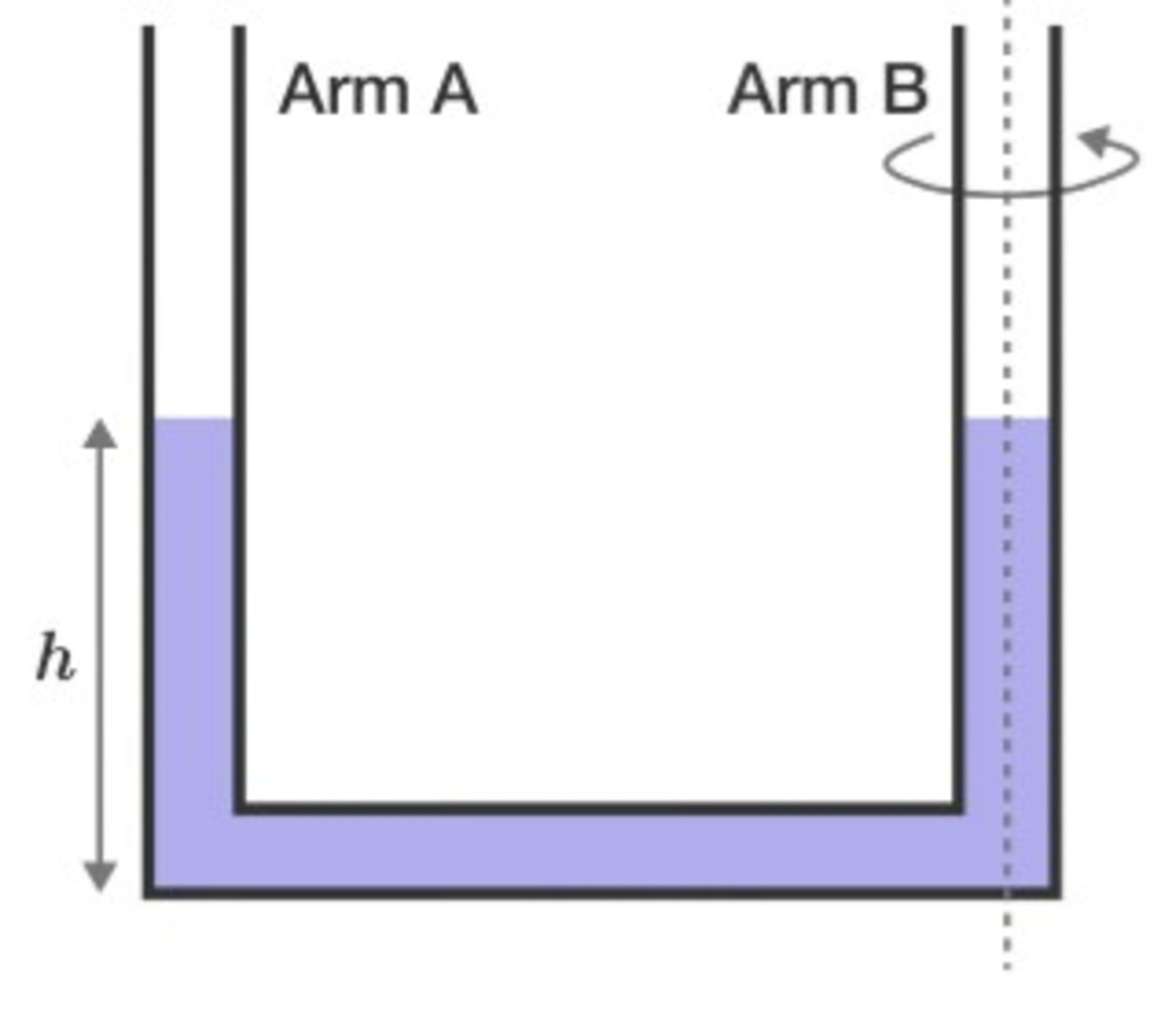Rotating U tube
A U-tube is filled with water to height h , as shown. Then the U-tube is spun at a constant rate about arm B.
What will happen to the water level in arm A?
This section requires Javascript.
You are seeing this because something didn't load right. We suggest you, (a) try
refreshing the page, (b) enabling javascript if it is disabled on your browser and,
finally, (c)
loading the
non-javascript version of this page
. We're sorry about the hassle.
8 solutions
Moderator note:
The centripetal force is a real force that causes something to move in a circle. As one example, the force that a rope exerts upon a ball that's swung in a circle is a centripetal force.
Centrifugal "force" is the apparent force that seems to be operating in a rotating reference frame. For example, if I try to stand on a merry-go-round (without securing myself), it seems there's a force pushing me toward the outside. In reality, my body simply wants to continue linear motion (since there's no force acting on it), so it seems like I'm being pushed off course. But when viewed from above, it's clear that I'm really just moving in a straight line.
In any case, the centripetal force is real and centrifugal is perceived. In this problem, once the apparatus is spinning, the water in Arm A and in the flat bottom needs to be acted on by a centripetal force to keep spinning in a circle. Part of this is provided by the pressure due to the water column in Arm B, which keeps both the water in the flat bottom and the water in Arm A from moving further out on the circle.
In turn, the water in Arm B feels a centripetal force from the walls which keeps it in place.
How about centripetal force? Will it affect the result?
Log in to reply
The centripetal force is a real force that causes something to move in a circle. As one example, the force that a rope exerts upon a ball that's swung in a circle is a centripetal force.
Centrifugal "force" is the apparent force that seems to be operating in a rotating reference frame. For example, if I try to stand on a merry-go-round (without securing myself), it seems there's a force pushing me toward the outside. In reality, my body simply wants to continue linear motion (since there's no force acting on it), so it seems like I'm being pushed off course. But when viewed from above, it's clear that I'm really just moving in a straight line.
In any case, the centripetal force is real and centrifugal is perceived. In this problem, once the apparatus is spinning, the water in Arm A and in the flat bottom needs to be acted on by a centripetal force to keep spinning in a circle. Part of this is provided by the pressure due to the water column in Arm B, which keeps both the water in the flat bottom and the water in Arm A from moving further out on the circle.
In turn, the water in Arm B feels a centripetal force from the walls which keeps it in place.
Log in to reply
Ah ok, thanks for the explanation!
I would appreciate it if You could explain what You mean when You say that the pressure provided by the water column in Arm B "keeps both the water in the flat bottom and the water in Arm A from moving further out on the circle."
If the (unsecured) water level in Arm A is rising, and what we are able to determine to be the immediate result by way of observation is the centrifugal force which is apparent to us to act on the water, which occurs as a result of the centripetal force exerted on Arm B, would the water's motion not be similar to a human body sliding off of a Merry-Go-Round? As such, "moving further out" on the "circle"?
Thanks in advance, please tag me in reply if that's possible, I appreciate the help!
I didn't really know how to do this so I kind of guessed. I think guess and check works best. Maybe next time I should have remembered the centrifugal force and used logical reasoning. I think I would rate this problem an 8 because it was pretty hard. I think I was able to persevere without giving up too quickly because I got to a conclusion.
Log in to reply
Do you feel like you understand what's going on now?
Doesn't the speed at which it is spun affect whether or not the water rises?
Log in to reply
I think it will only rises.
Log in to reply
The Force in Arm B should be higher, than in A. So the water in B rises faster, to equal the pressure the water in a will sink. Why not?
Log in to reply
@Niclas Schwalbe – Because the water all have same angular velocity, the centripetal force F = m r ω 2 which states that Force is proportional to radius, in case mass and angular velocity remain constant, so Arm A received more force than B.
I didnt understand your english. Nor the image didnt help understand your question. I thout you mean to spin water in B. Like tea with spoon...
Hi challenge master, it is a common misconception that centrifugal force is fictious. There are some forces that can be made to disappear by changing the frame of reference, but this is not one of them.
It is relatively simple to see this if you consider a ball on a string being swung in a circle. There is a tension in the string, and this tension muat be balanced by a force in the opposite direction if the ball is to maintain an approximately constant radius (simple conservation). That force is the centrifugal force.
The level in arm A will rise by h = 2 g ω 2 d 2 where d is the distance of the limbs from each other
Please explain the reason why the level of water in arm A will rise? This will help others to understand your solution better.
The Force in Arm B should be higher, than in A. So the water in B rises faster, to equal the pressure the water in a will sink. Why not?
here, for centrifugal force the water will want to go from B to A portion. so water level of A will rise.
Say the water and arm are moving in some direction, now, as the arm curves around and starts to change direction, the water still has moment in it's initial direction and wants to keep going that way. The difference in angle of the tube and the direction of the waters momentum pushes the water to the outside of the U-tube.
Centripetal, centrifugal; I forget tbh...either way, it acts perpendicularly to the applied force (circular horizontal) ---> ( translational vertical)..therefore downward force on point B + incompressible liquid = upward force at point A. (Side Note: neither translational nor incompressible are real words, but they totally should be because they make complete sense in this context - Physics >>> English ) [ and plz tell me if this justification is wrong/doesn't make sense b/c I'm 2/3 intoxicated & just beep boop bopping around rando math/physics sites for the lelz ]
The way I took to understand is: since Einstein proved there can't be a difference between an acceleration and gravity (and gravity is responsible for an equal level in a steady position), a centripetal acceleration will affect the sistem as a slight tilt to the left, rising the level of the liquid in arm A.
The force required for the rotation acts as centripetal force due to inter atomical force of attraction, inter molecular force of attraction, and other attractive forces keeps the material together but when arm b is considered as axis and the apparatus is rotated in a circular manner , the centrifugal force acting the tops are left free so the water level in arm 2 increases



Initially, the pressure of water is same in both the arms. As we start spinning the arm B, it results in an increased pressure on its bottom, which in turn pushes the water in the other arm upwards, as it experiences more pressure due to the pressure on the other arm. Hence the water level in arm A increases
Why would spinning increase the pressure on the bottom?
Say the water and arm are moving in some direction, now, as the arm curves around and starts to change direction, the water still has moment in it's initial direction and wants to keep going that way. The difference in angle of the tube and the direction of the waters momentum pushes the water to the outside of the U-tube.
Consider centrifugal force, the force act on the horizontal water tube and of Arm A, but horizontal one makes more effect.
The centrifugal force will makes the horizontal water tube go opposite side from Arm B which rise the water level in Arm A.